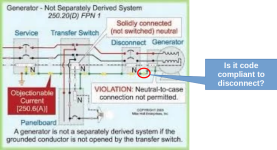Hi,
When I spec a generator, and in almost all the projects I worked on, my supervisor indicates that the generator is not considered as a separately derived system.
My question is, what drives this decision? when do consider a generator as a separately derived system?
Thanks for the help.
When I spec a generator, and in almost all the projects I worked on, my supervisor indicates that the generator is not considered as a separately derived system.
My question is, what drives this decision? when do consider a generator as a separately derived system?
Thanks for the help.


